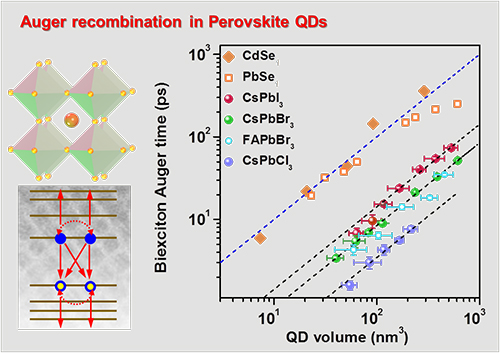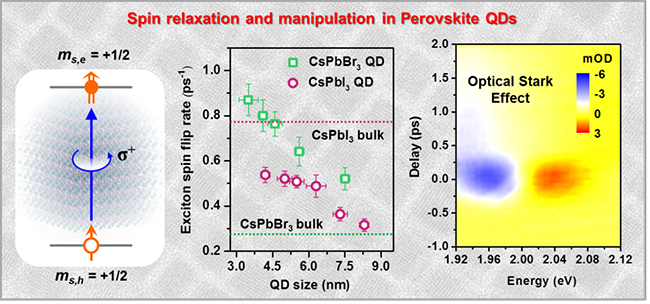A research group led by Prof. WU Kaifeng from the Dalian Institute of Chemical Physics (DICP) of the Chinese Academy of Sciences (CAS) revealed the scaling laws for the lifetimes of biexciton Auger recombination and exciton spin relaxation in perovskite QDs of various compositions by using femtosecond laser spectroscopy, It offeres important guidelines for the design of optoelectronic and spintronic devices based on perovskite QDs. These results were recently published in Angew. Chem. Int. Ed., ACS Energy Lett., and J. Phys. Chem. Lett.

Scaling laws for the lifetime of biexciton Auger recombination in lead halide perovskite QDs. (Image by LI Yulu)
Lead halide perovskite QDs hold strong promise for a variety of light harvesting, emitting and detecting applications, all of which, however, could be complicated by multicarrier Auger recombination. Therefore, a complete documentation of the size and composition dependent Auger recombination rates of these NCs is highly desirable, as it can guide the system design in many applications.
The scientists reported the synthesis and Auger measurements of monodisperse APbX3 (A= Cs and FA; X = Cl, Br, and I) NCs in an extensive size range (~3-9 nm). The biexciton Auger lifetime of all the NCs scaled linearly with the NC volume. The scaling coefficient was virtually independent of the cation but rather depended sensitively on the anion, which was 0.035, 0.085 and 0.142 ps per nm3 for Cl, Br, and I, respectively. All of these were much faster than that in standard CdSe and PbSe NCs (~1 ps per nm3).
Qualitative explanations based on the interband transition probabilities, density of final states and band structures were proposed, reflecting the unique photophysics of lead halide perovskite materials.
The volume-scaling laws determined by the authors allow for facile estimation of Auger recombination rates that are key parameters to be considered in perovskite NC-based devices.

Spin relaxation measurements and strong spin-selective optical Stark effect in lead halide perovskite QDs. (Image by LI Yulu)
In addition to optoelectronic applications, the strong spin-orbital coupling (SOC) in lead halide perovskites allows for facile spin injection for spintronic applications. On the other hand, however, the strong SOC also limits the lifetime of the injected spins. Full-dimensional confinement of the carriers using QDs has been envisioned as an effective means to prolong the spin relaxation lifetime and has been explored for II-VI and III-V group QDs.
The scientists applied this idea to colloidal lead halide perovskite QDs and measured the exciton spin dynamics of QDs of varying sizes and compositions using circularly polarized transient absorption spectroscopy at room temperature.
The spin lifetimes of CsPbI3 and CsPbBr3 QDs were prolonged and shortened, respectively, as compared to their bulk counterparts. Both CsPbI3 and CsPbBr3 QDs showed decreasing spin lifetime with decreasing QD size. Possible spin relaxation mechanisms, including those that are unique to these quantum-confined systems, were proposed, with important ramifications for the use of these perovskite QDs in spin-related applications.
The strong SOC in lead halide perovskites is also useful for optical Stark effect (OSE) that is important for spin manipulation using pure optical methods. A strong OSE would benefit from discrete energy levels and a strong band edge transition with concentrated oscillator strength, which, again, can be realized in three-dimensionally confined QDs.
The scientists reported the observation of strong OSE in perovskite colloidal QDs using circularly polarized transient absorption spectroscopy. The large OSE shifts correspond to transition dipoles as large as 52 Debye, which compared favorably to those recently reported for higher-dimensional perovskites as well as transition metal dichalcogenide monolayers.
Colloidal synthesis also allowed for facile tuning of the OSE spectral ranges of perovskite QDs via sizes and compositions, and the impact of these parameters on the OSE was examined, providing fundamental insights into the band edge transition of lead halide perovskites.
This work was supported by the National Natural Science Foundation of China, the Ministry of Science and Technology of China, the Chinese Academy of Sciences and the LiaoNing Revitalization Talents Program. (Text by LI Yulu)